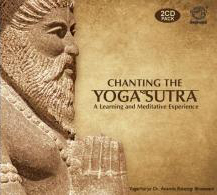
CHANTING THE YOGA SUTRA: A LEARNING AND MEDITATIVE EXPERIENCE
Includes: 2 CD set, plus 52-page guide:
About This CD: Chanting led by Yogacharya Dr Ananda Balayogi Bhavanani with support by Yogacharini Devasena Bhavanani, Yoga Chemmal Meena Ramanathan and Yogacharini Dr Sangeeta. Recording engineer and flute by Shri Rajkumar Rajamanickam
Disc 1: A Meditative Experience: Invocation to Maharishi Patanjali, Samadhipada, Sadhanapada, Vibhutipada, Kaivalyapada and 108 OM chants
Disc 2: A Learning Experience: Invocation to Maharishi Patanjali, Samadhipada, Sadhanapada, Vibhutipada, Kaivalyapada
Why do we chant the Yoga Sutra’s of Maharishi Patañjali? When we write things out and deal with the written word, we are dealing with external forms. The written form is the grossest level of interpretation of oral traditions. When we chant we use our vocal apparatus to produce the sound. This process brings us into the eternal NOW. When we write, a long lapse of time can pass between the time of writing and our re-reading it. When we chant, the action brings us in the present moment. The process of chanting demands full attention, at least at the physical level. There is also the question of resonance. Chanting evokes and invokes resonance in letters and words. All mantra’s can be chanted in three forms: the manasika form (chanting in the mind) is the subtlest of forms, the vachika form (chanting externally, uttering sound) is in between, and the likita (writing), which is the grossest. The subtlest way to approach the sutra’s would be to chant them at the level of the mind. Yet, this requires full knowledge of what one is doing. It follows that when we chant we are in the NOW, we are vibrating, and we know what we are uttering so that when we move to the subtlest plane and we chant without uttering sound, in our mind, we are as close to the most perfect sound as possible.
Close this window to return to ICYER Books and CDs